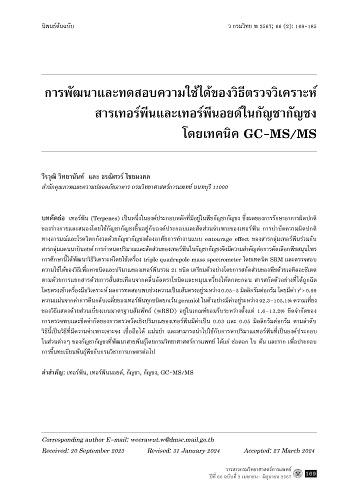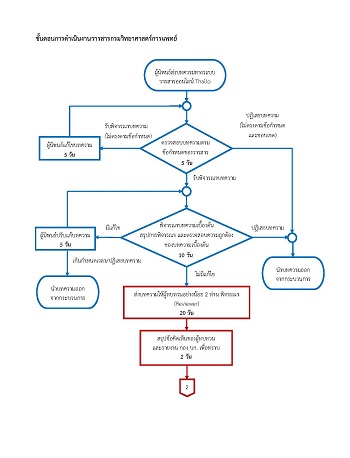การพัฒนาและทดสอบความใช้ได้ของวิธีตรวจวิเคราะห์สารเทอร์พีนและเทอร์พีนอยด์ในกัญชากัญชงโดยเทคนิค GC-MS/MS
การวิเคราะห์สารเทอร์พีนในกัญชากัญชง
คำสำคัญ:
เทอร์พีน, เทอร์พีนนอยด์, กัญชา, กัญชง, GC-MS/MSบทคัดย่อ
เทอร์พีน (Terpenes) เป็นหนึ่งในองค์ประกอบหลักที่มีอยู่ในพืชกัญชากัญชง ซึ่งผลของการรักษาอาการผิดปกติของร่างกายและสมองโดยใช้กัญชากัญชงขึ้นอยู่กับองค์ประกอบและสัดส่วนจำเพาะของเทอร์พีน การบำบัดความผิดปกติทางอารมณ์และโรควิตกกังวลด้วยกัญชากัญชงต้องอาศัยการทำงานแบบ entourage effect ของสารกลุ่มเทอร์พีนร่วมกับสารกลุ่มแคนนาบินอยด์ การกำหนดปริมาณและสัดส่วนของเทอร์พีนในกัญชากัญชงจึงมีความสำคัญต่อการคัดเลือกพืชสมุนไพร การศึกษานี้ได้พัฒนาวิธีวิเคราะห์โดยใช้เครื่อง triple quadrupole mass spectrometer โดยเทคนิค SRM และตรวจสอบความใช้ได้ของวิธีเพื่อหาชนิดและปริมาณของเทอร์พีนรวม 21 ชนิด เตรียมตัวอย่างโดยการสกัดส่วนของพืชด้วยเอทิลอะซีเตต ตามด้วยการแยกสารด้วยการสั่นสะเทือนจากคลื่นอัลตราโซนิคและหมุนเหวี่ยงให้ตกตะกอน สารสกัดตัวอย่างที่ได้ถูกฉีดโดยตรงเข้าเครื่องมือวิเคราะห์ ผลการทดสอบพบช่วงความเป็นเส้นตรงอยู่ระหว่าง 0.05–5 มิลลิกรัมต่อกรัม โดยมีค่า r2 > 0.99 ความแม่นจากค่าการคืนกลับเฉลี่ยของเทอร์พีนทุกชนิดยกเว้น geraniol ในตัวอย่างมีค่าอยู่ระหว่าง 92.3–105.1% ความเที่ยงของวิธีแสดงด้วยส่วนเบี่ยงเบนมาตรฐานสัมพัทธ์ (%RSD) อยู่ในเกณฑ์ยอมรับระหว่างตั้งแต่ 1.6–13.2% ขีดจำกัดของการตรวจพบและขีดจำกัดของการตรวจวัดเชิงปริมาณของเทอร์พีนมีค่าเป็น 0.03 และ 0.05 มิลลิกรัมต่อกรัม ตามลำดับ วิธีนี้เป็นวิธีที่มีความจำเพาะเจาะจง เชื่อถือได้ แม่นยำ และสามารถนำไปใช้กับการหาปริมาณเทอร์พีนที่เป็นองค์ประกอบในส่วนต่าง ๆ ของกัญชากัญชงที่พัฒนาสายพันธุ์โดยกรมวิทยาศาสตร์การแพทย์ ได้แก่ ช่อดอก ใบ ต้น และราก เพื่อประกอบการขึ้นทะเบียนพันธุ์พืชกับกรมวิชาการเกษตรต่อไป
เอกสารอ้างอิง
Pichersky E, Raguso RA. Why do plants produce so many terpenoid compounds? New Phytol 2018; 220(3): 692-702.
Lange BM. The evolution of plant secretory structures and emergence of terpenoid chemical diversity. Annu Rev Plant Biol 2015; 66: 139-59.
Booth JK, Bohlmann J. Terpenes in Cannabis sativa - from plant genome to humans. Plant Sci 2019; 284: 67-72.
Grotenhermen F. Pharmacology of cannabinoids. Neuro Endocrinol Lett 2004; 25(1-2): 14-23.
Whiting PF, Wolff RF, Deshpande S, Di Nisio M, Duffy S, Hernandez AV, et al. Cannabinoids for medical use: a systematic review and metaanalysis. JAMA 2015; 313(24): 2456-73.
Russo EB. Taming THC: potential cannabis synergy and phytocannabinoid-terpenoid entourage effects. Br J Pharmacol 2011; 163(7): 1344-64.
Ahmed SA, Ross SA, Slade D, Radwan MM, Khan IA, ElSohly MA. Minor oxygenated cannabinoids from high potency Cannabis sativa L. Phytochemistry 2015; 117: 194-9.
Giese MW, Lewis MA, Giese L, Smith KM. Development and validation of a reliable and robust method for the analysis of cannabinoids and terpenes in cannabis. J AOAC Int 2015; 98(6): 1503-22.
Brown AK, Xia Z, Bulloch P, Idowu I, Francisco O, Stetefeld J, et al. Validated quantitative cannabis profiling for Canadian regulatory compliance - cannabinoids, aflatoxins, and terpenes. Anal Chim Acta 2019; 1088: 79-88.
Fischedick JT, Hazekamp A, Erkelens T, Choi YH, Verpoorte R. Metabolic fingerprinting of Cannabis sativa L., cannabinoids and terpenoids for chemotaxonomic and drug standardization purposes. Phytochemistry 2010; 71(17-18): 2058-73.
Brenneisen R. Chemistry and analysis of phytocannabinoids and other Cannabis constituents. In: Marijuana and the cannabinoids. Totowa, NJ: Humana Press; 2007. p. 17-49.
Booth JK, Yuen MMS, Jancsik S, Madilao LL, Page JE, Bohlmann J. Terpene synthases and terpene variation in Cannabis sativa. Plant Physiol 2020; 184(1): 130-47.
Casano S, Grassi G, Martini V, Michelozzi M. Variations in terpene profiles of different strains of Cannabis sativa L. Acta Hort 2011; 925: 115-21.
Lockwood GB. Techniques for gas chromatography of volatile terpenoids from a range of matrices. J Chromatogr A 2001; 936(1-2): 23-31.
Antalick G, Perello MC, de Revel G. Development, validation and application of a specific method for the quantitative determination of wine esters by headspace-solid-phase microextraction-gas chromatography–mass spectrometry. Food Chem 2010; 121(4): 1236-45.
Shapira A, Berman P, Futoran K, Guberman O, Meiri D. Tandem mass spectrometric quantification of 93 terpenoids in Cannabis using static headspace injections. Anal Chem 2019; 91(17): 11425-32.
Marchini M, Charvoz C, Dujourdy L, Baldovini N, Filippi JJ. Multidimensional analysis of cannabis volatile constituents: identification of 5,5-dimethyl-1-vinylbicyclo[2.1.1]hexane as a volatile marker of hashish, the resin of Cannabis sativa L. J Chromatogr A 2014; 1370: 200-15.
AOAC International. Appendix F: guidelines for standard method performance requirements. In: AOAC official methods of analysis.[online]. 2016; [18 screens]. Available from: URL: https://www.aoac.org/wp-content/uploads/2019/08/app_f.pdf.
Namdar D, Mazuz M, Ion A, Koltai H. Variation in the compositions of cannabinoid and terpenoids in Cannabis sativa derived from inflorescence position along the stem and extraction methods. Ind Crops Prod 2018; 113: 376-82.
Adams DJ, Dyson PJ, Tavener SJ. Chemistry in alternative reaction media. Chichester, UK: John Wiley & Sons; 2005.
Delgado-Povedano MM, Sánchez-Carnerero Callado C, Priego-Capote F, Ferreiro-Vera C. Untargeted characterization of extracts from Cannabis sativa L. cultivars by gas and liquid chromatography coupled to mass spectrometry in high resolution mode. Talanta 2020; 208: 120384.

ดาวน์โหลด
เผยแพร่แล้ว
รูปแบบการอ้างอิง
ฉบับ
ประเภทบทความ
สัญญาอนุญาต
ลิขสิทธิ์ (c) 2024 วารสารกรมวิทยาศาสตร์การแพทย์

อนุญาตภายใต้เงื่อนไข Creative Commons Attribution-NonCommercial-NoDerivatives 4.0 International License.



